Pulp Alley is a set of rules for a handful of figures on a small gaming area. 2 sides with 6 models each on a 3′ square gaming area should do the job. Rather than going through the rules line by line the best starting point is to track down the free rules and cards on the Pulp Alley website.
I can confirm that I have played the game using just the free version of the rules and the free cards. In my case the office printer donated the paper and toner. I used up some spray fixing glue but re-used old card wallets and mounted the cards on ‘donated’ card stock. I did cheat and source 2 sets of league stats from the web. The full rules for creating leagues is not in the free book, there are 2 ready to go leagues provided but these did not match up well with the miniatures that I had available. When running the free game it transpired that at least 1 full game rule (dealing with hiding) was missing but ignoring the rule did not affect the game. There is only 1 scenario in the free rules compared to 6 in the full rules and that 1 is not especially exciting. Still you do get to play almost the full system without worrying about the cost. As this set is a pdf download there is not much waiting either, just the time to print out and mount the bits.
I have now bought the full rules and found that there was very little present that I did not get from the free version. I then bought Pulp Leagues. This includes some additional rules and an expanded set of league creation rules compared to that in the full basic rules. From a monetary point of view I would suggest buying Pulp Leagues after getting the free rules and only to get the full rules for completeness. Not having the full rules will miss out some bits but the Pulp Leagues creation system is better than that in the basic rules. The marketing problem is that you get so little extra when moving from the free to paid rules it is scarcely worth the upgrade. Pulp Alley has an intuitive rules system that is forgiving of mistakes and makes it easy to invent house rules that fit in with the system.
Without the main rules you could be short of scenarios. The solution here is to get Tomb of the Serpent, the most recent scenario book. This is chock full of scenarios although I have avoided reading most of them as I plan to play them through and do not want to spoil the campaign story. Tomb of the Serpent is loosely Egyptian based. I bought a sprue of Frostgrave cultists for some of the baddies. GW Tomb Kings type figures ought to do for the rest. I do not have any of those so GW Lizardmen may have to substitute in. The campaign could be modified to other settings without any serious effect on game play. Another key reason to get Tomb of the Serpent is that the pdf version includes card print outs for the solo and horror decks. The web store also sells these separately but does not make it clear that they are included with the rules for their use in this supplement.
I have not seen the Vice Alley supplement. As I have no gangster or similar figures I will not be going there. The other ‘mainstream’ supplement is Pulp Gadgets, Guns and Vehicles. Annoyingly there is a reference to the big gun rules in this supplement within Pulp Leagues but not the full rules for using them. At present I will stick with making up any rules that I need to cover this area. Really big guns are going to dominate this sort of skirmish game. I would imagine a 6-8 turn game being just long enough for a team to set up and unpack a big gun. So a game can be set out to complete a task before the big gun is ready to fire, hence it needs no specific rules.
The Pulp Alley characters have a set of statistics stated in terms of rolling a number of dice of differing sides, D6, D8, D10 and rarely D12. Success is based on scoring a 4+ so a lowly single D6 has a 50% chance of success and a D10 70% (0s are 10 on the die roll). Combat involves the shooting, brawling and dodge statistics. Other characteristics are rolled when solving puzzles or when in hostile terrain. In ranged or close combat both sides roll their dice and note the successes. The attacker, only, has the option to spend some success dice to cancel out the defender’s successes on a 1 for 1 basis. This represents blocking punches or spray fire to keep the opposition’s head down. It is rather gamey that this choice is made after the dice roll rather than declaring an intention before rolling but it keeps the game moving. The defender can elect to roll dodge rather that combat dice. These will cancel the attacker’s dice but cannot possibly harm them. It has the advantage that it can be combined with a short dodge move to get the figure out of harm’s way. Combat is one on one but if a character is involved in multiple combats on 1 turn they will fight progressively worse. As both sides in a combat can inflict damage a low dice rolling figure needs to think carefully before engaging its betters. Hits are converted to wounds by failing a health roll. The health die (characters only have a single health die) is used to try and cancel all hits. If you get hit 3 times there are 3 chances to cancel but if only 1 hit is not cancelled the character is wounded. A wound will result in dropping a health dice level but there is a 1 in 6 chance of recovering the wound at the end of the turn. Low health dice units have less dice to lose so are not going to last as long. Only 1 health level can be lost per combat but not per turn. With some dice luck multiple attacks from low dice characters are going to cause multiple dice drops and perhaps knock out a high level character. When following this plan some of those low dice minions are likely to be taking one for the team.
In the basic rules all ranged combat is the same. The game does not differentiate between a throwing knife and a SMG. At these skirmish ranges and with plenty of cover this is probably not a serious issue. Pulp Leagues does include more types of weapon with slight changes in how they fire but the list is short. None of the changes consider that some weapons might do more damage when they hit than others. A possible reason for the American Indians preferring the musket to their native bows was the improved stopping power of the musket. Another concept that is not covered is that some weapons are more awkward to use than others. A firearm can be shot from cover with little exposure to the shooter. A bow or spear requires the shooter to expose some of their body when preparing to loose or throw. I have not come across rules for these situations in Pulp Alley but the system could easily accommodate them.
Setting up a league for a straight up shoot out is not very successful. The game improves through the use of the scenarios and these rely on plot points. Plot points are victory objectives and they require passing die rolls on characteristics other than those used in combat. The weaker characters have poor dice settings so are much less likely to solve plot points. They can spread solving a plot point over several turns but that does rely on nothing else happening to them. The plot points should be modelled as NPCs to talk to, chests to open or sacks to search. Strictly following the rules allows any character to solve any plot. This could include having the gorilla talk to the NPC and find the location of the treasure map. Some pre-game thought would be required in cases such as those.
After 2 rough games to get the feel of the system I am trying the first of the Tomb of the Serpent scenarios. All my figures are set up for Darkest Africa, having been drawn in by the excellent Congo rules. I will be using the solitaire deck. This cuts out the interesting initiative and card interaction rules but obviously facilitates solo play. Both sides share the solo deck. The player decides the first 3 characters to activate and each draws a card from the solo deck. These cards can be good or bad, some are instant and others stick with the activated figure. There are simple rules for how the opposing side will act but making the best possible choice for them will also work.
Our first outing is to the fairground. Making use of what models I have this will be to a World’s Fair exhibition in London. Specifically to the Darkest Africa section. The exhibits include a selection of freaks and weirdos to pull in the crowd. I am hoping that one of these will reveal our first clue.
The reader may notice that one of the above has a slight birthmark. This is the enlightened 19th century so we do not talk about such things in polite company. He is able to make a worthwhile contribution to society as an exhibit in a freak show.
It is not going to be a walk in the park. These mysterious cultists are also after clues. The tall guy is a Heroclix repaint and the others are Frostgrave cultists with Warlord Bolt Action weapons.
Our small league of heroes left 3 slots available for league perks. These resulting in 1 cultist not showing until turn 2 and our heroes being joined by a low level supporter for this episode only.
Set up for both sides required being 6″ from a plot point and 1″ from the enemy. This gave a fairly even spread and preventing any attempts to get clues on turn 1. You have to run to go above 6″ and when running cannot perform an action (except brawling). Any character who shoots or brawls during the game suffers a string of perils as they are set upon by the crowd. This was a constant upset for the lower level cultists.
On turn 2 our leader solved the first clue and learnt that the Pigmy King was the man to help us out. Unfortunately the closest character to him was the cultist leader who ran over to begin some gentle persuation on turn 3.
The cultist leader and our own hero avoided any direct combat so as to make it easier to get around and solve clues. The cultist leader did well scoring half the successes needed to weedle the main clue from the Pigmy King on his first attempt. Some desparate work from our heroes knocked him down once and kept him weak so his health never got above d6.
This pegged his other stats at d6 and made it hard to persuade the Pigmy King who in turn knocked him about helping to keep his health down.
Our party just about held off the cultists until our leader came up, still in good d10 health and with a reward card to help kneedle the reward from the Pigmy King at the end of turn 6.
At the beginning of turn 7 he manfully ran off with his reward pursued by the cultist leader. Although caught our hero was easily able to knock back the cultist leader.
The game took about 1 hour to play through the 7 turns (1 added by game event). The solo deck was cycled through once with 1 card after the shuffle. Most of the action revolved around the major plot point held by the Pigmy King. Having identified this it made sense for both sides to concentrate on it although interacting with the other NPCs could have brought rewards to help with passing the clue success test. No one dared to go in the tent with the purple guy or perhaps they were too tight to shell out the 3d entry fee.

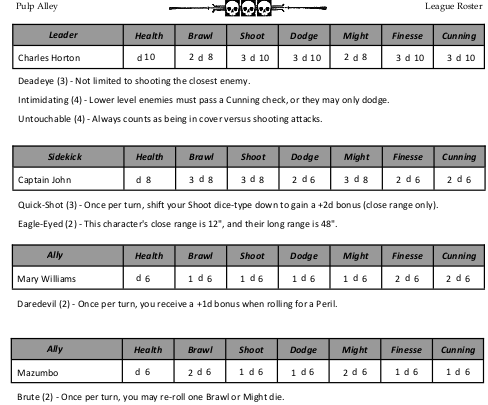
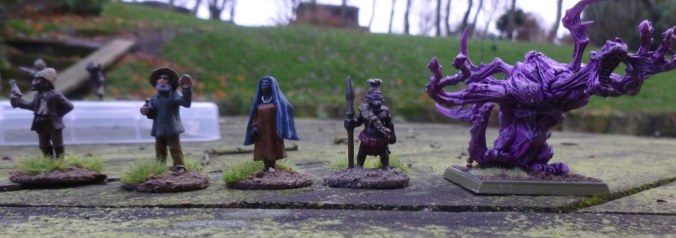
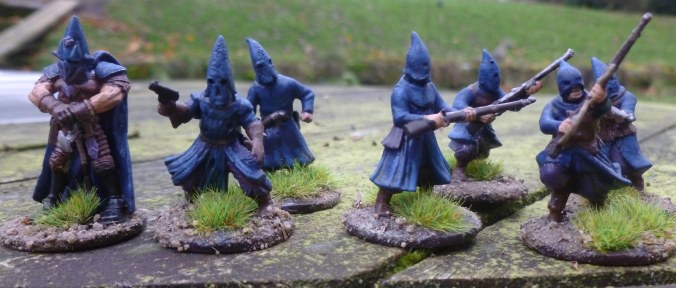
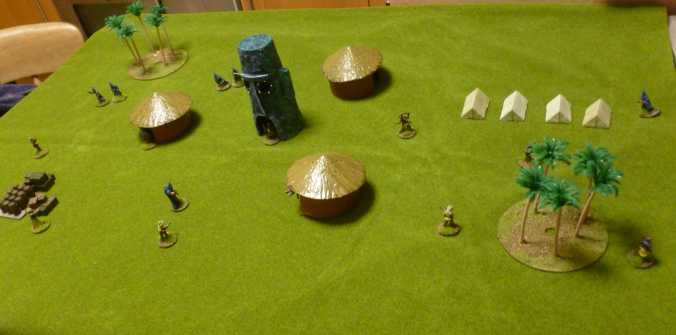

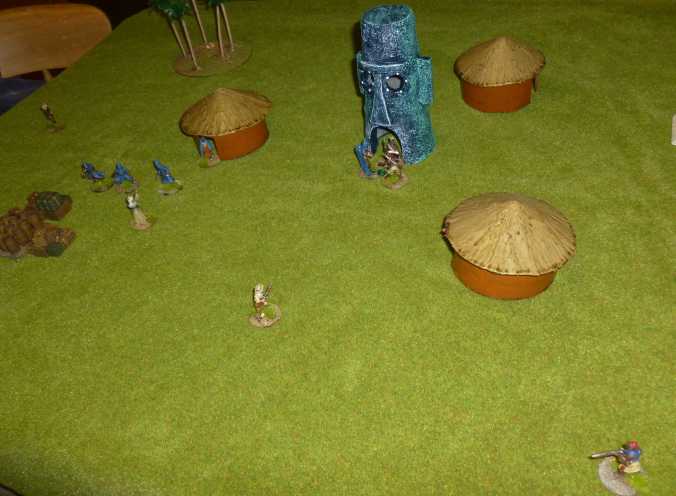

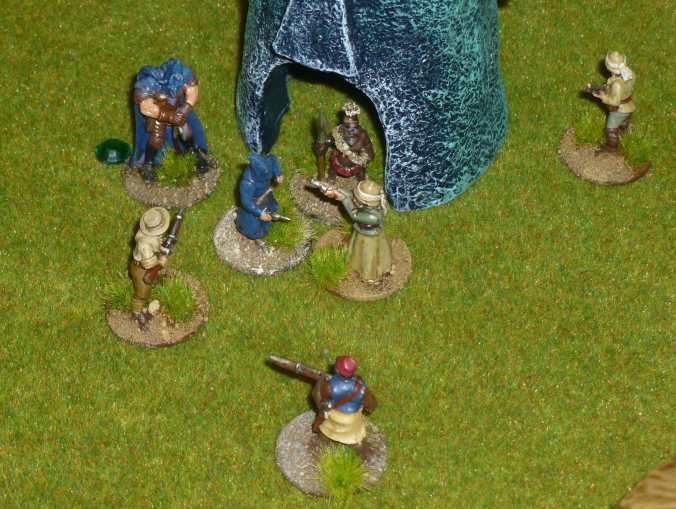
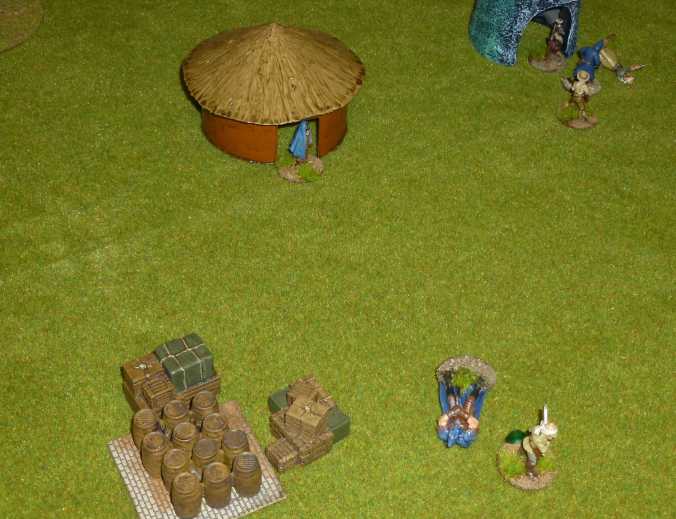
What is the wonderful purple figure, please ??
Love your customized cultists !
LikeLike
I think that the purple figure is an early GW metal chaos spawn. The Warlord arms are a surprisingly good match for the Frostgrave cultists.
LikeLike
I can confirm the purple figure is a Chaos Spawn from around the late 90s/early 00s. Also – “You have to run to go above 6″ and when running cannot perform an action (except brawling).” Actually, you can also shoot – it’s just at a -1. The only real “action” in the core rules is attempting a plot point — scenarios may also have specific actions of course. (I only mention this because I made the same mistake thinking you couldn’t run and shoot).
Fun report – I’ve just purchased the rules and am really enjoying them so I’ve been looking for AARs.
LikeLike